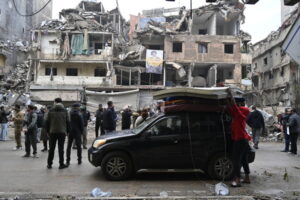Tens of thousands of people, driven fleeing by the war between Israel and Hezbollah, made their way home yesterday (Wednesday), with many finding their towns and villages hugely devastated after a ceasefire agreement went into effect in the early hours of this morning.
The truce ended a conflict that began more than 13 months ago between the Lebanese Shiite movement and Israeli armed forces and turned into open warfare in September. Some 900,000 people were forced to flee their homes in Lebanon, according to the UN, as were some 60,000 civilians in northern Israel.
Already before dawn, displaced people from southern Lebanon, southern Beirut and the Bekaa Valley in the eastern part of the country, Hezbollah strongholds, began returning by the thousands, in cars and minibuses loaded with people and luggage.
In the ruins of southern Beirut, Hezbollah supporters raised its flag and held portraits of its iconic former leader Hassan Nasrallah, who was killed in late September in a much-hyped Israeli aerial bombing.
“This heroic neighborhood” finally “won, we are proud,” said Nizam Hamade, an engineer.
The Shiite movement, whose leadership was decimated in the Israeli bombing, nevertheless proclaimed its “victory”, assuring that its fighters “will remain fully prepared to face (…) the attacks of the Israeli enemy”.
Returning to Nabatiya, in southern Lebanon, Ali Mazraani said he felt “shocked” when he saw “the huge destruction” of his city, which seemed to him like a “foreigner”.
“Despite the scale of the destruction and our sadness, we are happy to be back,” said Umm Mohamed Bzai, a 44-year-old widow who found her house in ruins in the village of Zebkin. “We feel like we have been reborn.”
On October 8, 2023, Hezbollah, a movement affiliated with Iran, was opening a front with Israel to support Hamas, the day after the Palestinian Islamist movement’s unprecedented assault on the southern part of Israeli territory that sparked the war in the Gaza Strip.
After nearly a year of cross-border exchanges of fire and after considering itself to have weakened Hamas in the Gaza Strip, Israel shifted the focus of the war to Lebanese territory, launching a campaign of massive aerial bombing against Hezbollah strongholds beginning on September 23 and moving on to a ground offensive in southern Lebanon seven days later.
Under the terms of the US- and French-brokered agreement, Israeli armed forces have 60 days to withdraw progressively from southern Lebanon. Hezbollah is required to withdraw north of the Litani River, some thirty kilometers from the border, and dismantle its military infrastructure in southern Lebanon.
The Lebanese army said yesterday that it had begun, “in coordination” with the UN peacekeeping force, to reinforce its presence in the south of the country.
The Israeli armed forces, on the other hand, warned residents not to approach their positions.
“We are controlling positions in southern Lebanon, our aircraft continue to fly in the Lebanese skies (…) Today, we arrested suspects and killed terrorists,” their spokesman Daniel Hagari said, adding that “180 targets” were hit in the last hours before the ceasefire agreement came into effect.
According to Lebanese authorities, at least 3,823 people have died in Lebanon since October 2023, the vast majority since late September. On the Israeli side, 82 military personnel and 47 civilians have died in attacks and clashes with Hezbollah, according to the official count.
According to Joe Biden, the agreement will prevent “what remains of Hezbollah and other terrorist organizations” from “threatening Israel’s security again.”
Washington and Paris relied on UN Security Council Resolution 1701 (2006), which concerned the end of the previous war between Israel and Hezbollah and stipulated that only the UN peacekeeping force and Lebanese armed forces would remain deployed in southern Lebanon.
Israel retains “full freedom of military action in Lebanon”, and “if Hezbollah violates the agreement and attempts to rearm, we will attack,” Prime Minister Benjamin Netanyahu asserted.
The Shiite movement will work with the Lebanese state to deploy the country’s army in the south, its MP Hassan Fadlala assured the French news agency yesterday. But its members “are children in the villages” of the south, from which “no one” can expel them, he added.
After more than a year of rushing to shelters every time the air defense sirens sounded, many residents of northern Israel were enjoying the calm yesterday, though not completely relaxed.
In Nahariya, a coastal town within range of rockets fired from Lebanese territory, Baha Arafat, 44, said he felt relieved. “I feel much better now that I know we have a ceasefire,” he confided, “There is no nearby shelter here and the last few days have been very tense.”
“There is a feeling of greater security, our children can go back to school,” Yuri, 43, displaced from kibbutz Yiron, near the border, in Haifa, pleaded.
But “we don’t feel completely reassured” as “Hezbollah still has forces,” he added.
According to Netanyahu, the ceasefire will allow Israel to “focus on the Iranian threat” and “intensify” pressure on Hamas.
Commentators in Israel have expressed skepticism, however, with some expressing concern that Hezbollah will regroup its forces, or pointing to the lack of any progress in reaching a ceasefire agreement in the Gaza Strip, where the war continues for the 419th day.
Israel intends to “make all necessary efforts to create the conditions” that will allow “a new exchange of hostages” with Palestinian detainees in Israeli detention centers, Israeli Defense Minister Israel Kats assured.
With less than two months left in his term, Joe Biden promised to resume efforts to reach a ceasefire agreement in the Gaza Strip, with input from “Turkey, Qatar, Egypt and other actors in the region,” according to Jake Sullivan, the White House national security adviser.
A Hamas official assured Agence France-Presse yesterday that the Palestinian Islamist movement is “ready” to conclude a ceasefire agreement in the Gaza Strip.
However, the health ministry of the Hamas government announced last night the death of nine people in an Israeli bombing in Gaza City, where a displaced persons shelter at a school in the Daraza district was hit. For its part, the Israeli army said in a statement that it had “eliminated the terrorist Murad Razub,” one of “two perpetrators of a bombing that had caused some ten injuries in Beersheva” in southern Israel “in May 2002.”
The Israeli army also referred to bombing in the battlefield encompassing Jabalia and Beit Lahia, also in the northern part of the Palestinian enclave. “During the operation” “air strikes” and “cluster engagements to eliminate terrorists” were carried out, according to the army. The same statement referred to “Hamas terrorists (who) fired anti-tank missiles from the Indonesian hospital.”
Hamas, for its part, denounced the “continuation of the criminal operation in the northern Gaza Strip” by the Israeli army.
For its part, the civil defense said that only one ambulance is now operating in the entire area due to a lack of diesel fuel.
The war that erupted on October 7, 2023 was triggered by a storming of the Hamas military arm in the southern part of Israeli territory, which claimed the lives of 1.207 people, the majority of them civilians, according to a French News Agency count based on official data, which includes hostages who died in captivity or were already dead when they were brought into the Palestinian enclave.
The devastating, large-scale Israeli military retaliatory operations in the Gaza Strip have since claimed the lives of at least 44,282 people, the majority of them civilians, according to figures from the Hamas health ministry, which are described as reliable by the UN.
Ask me anything
Explore related questions





